Some national parks can be hidden gems of their region, revealing their unique charm and beauty only to the most curious visitors. However, there are also natural areas that, thanks to their international fame, have almost become symbols of an entire country. At the top of this list, right next to the Grand Canyon, stands Yellowstone National Park.
Yellowstone National Park is considered the oldest national park in the world. Located in the western part of the United States, over 90% of the park lies within the state of Wyoming, with smaller portions extending into Montana and Idaho. This park is one of the most well-known protected natural areas on Earth. Its fame comes from its pristine, wild nature, the thousands of species of flora and fauna that inhabit the area, and above all, the rare geothermal activity that sets it apart from other places. You’ve likely heard of Yellowstone National Park many times before, but today it’s time to uncover its greatest secrets.
The history of the world’s oldest park
More than 10,000 years before the establishment of the official national park, Native Americans lived and hunted in the Yellowstone area. They gathered plants, extracted obsidian, and used the thermal waters for religious and medicinal purposes.
They were not only the inhabitants of these lands but also the first defenders of nature. After all, its valuable resources and cultural significance were too precious for the native people to allow anyone to destroy them.
Reports of hissing ground, multicolored hot springs, and erupting geysers from other inhabitants of North America were dismissed as tall tales. This remained the case until 1869, when formal expeditions began into what is now Yellowstone. The natural wonders of the area were discovered, documented through photographs and written accounts, and ultimately, Congress was convinced that this land was worth special protection.
By an act of Congress, signed on March 1, 1872, by President Ulysses Grant, the first official national park in the world was established. Initially, the park was protected by the U.S. Army, and in 1916, management was handed over to the National Park Service. In 1978, Yellowstone National Park was added to the UNESCO World Heritage List.
Characteristics of Yellowstone Park
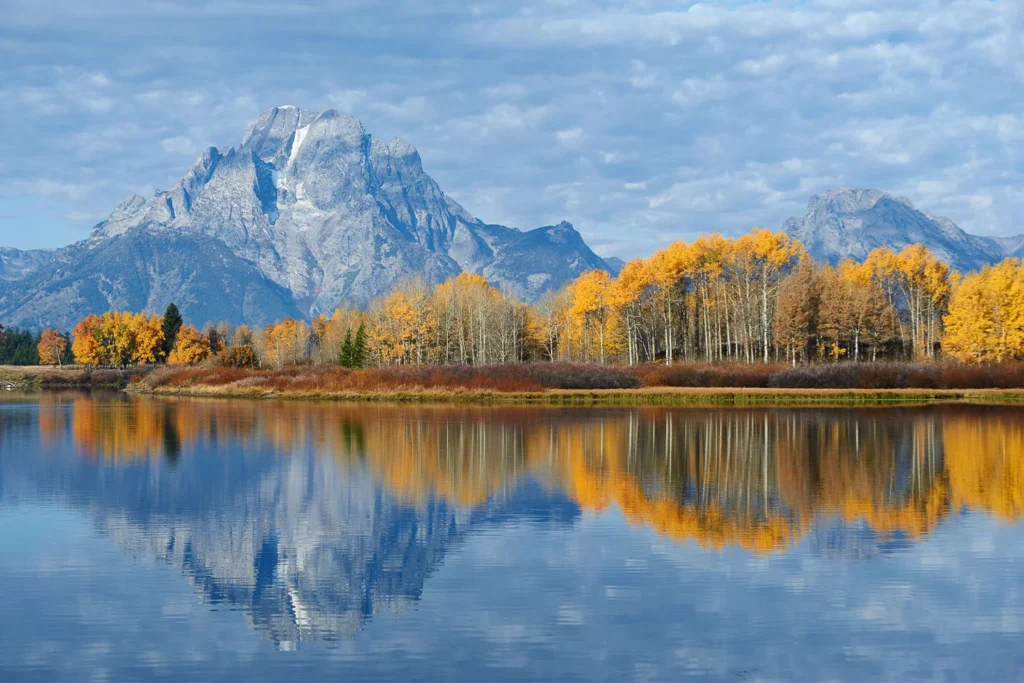
The nature of this place is surprising in every way. Yellowstone National Park covers an area of nearly 9,000 square kilometers. To put that in perspective, it’s larger than the combined land area of Rhode Island and Delaware. The park sits on a vast volcanic plateau, which means about 10 kilometers below the surface lies a massive supervolcano—a 70-kilometer-wide chamber filled with bubbling magma. This geological phenomenon is what powers the park’s impressive geyser displays.
Yellowstone is currently considered the largest, nearly intact temperate-zone ecosystem on Earth. It boasts 290 waterfalls and is home to the highest concentration of wildlife in the lower 48 states. Ready to discover what other wonders this incredible place holds?
Geysers and Hot Springs
The geothermal features of Yellowstone are undeniably its top attraction, drawing the largest number of visitors. The most famous geyser in the park—and perhaps the world—is Old Faithful, located in the Upper Geyser Basin. This natural wonder erupts a stream of steam and boiling water approximately every 92 minutes! If you happen to be nearby, it’s well worth waiting for this spectacular show, as a column of water shoots up to 60 meters high. The park is also home to the Steamboat Geyser, the tallest active geyser in the world. But that’s not all—Yellowstone contains more than half of the world’s geysers and geothermal features, offering plenty of other, though less famous, spots to explore.
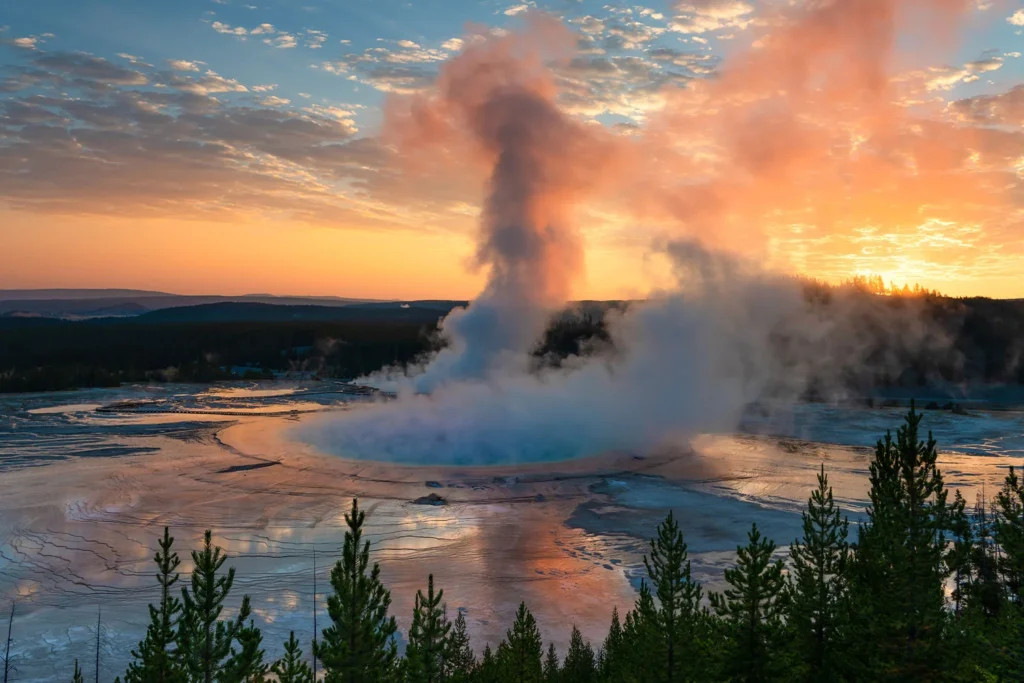
The colorful, boiling water pools are the stars of many striking photographs of the USA’s flagship national park. But what exactly are these rainbow-like springs? The answer is fascinating: these water environments are home to microscopic organisms called thermophiles. While too small to be seen individually, trillions of them clustered together appear as vibrant masses of color. Colorless and yellow thermophiles thrive in the hottest water, while orange, brown, and green thermophiles inhabit cooler temperatures. The most frequently sought-out hot spring in Yellowstone is Grand Prismatic Spring, the largest in the park and the third largest in the world.
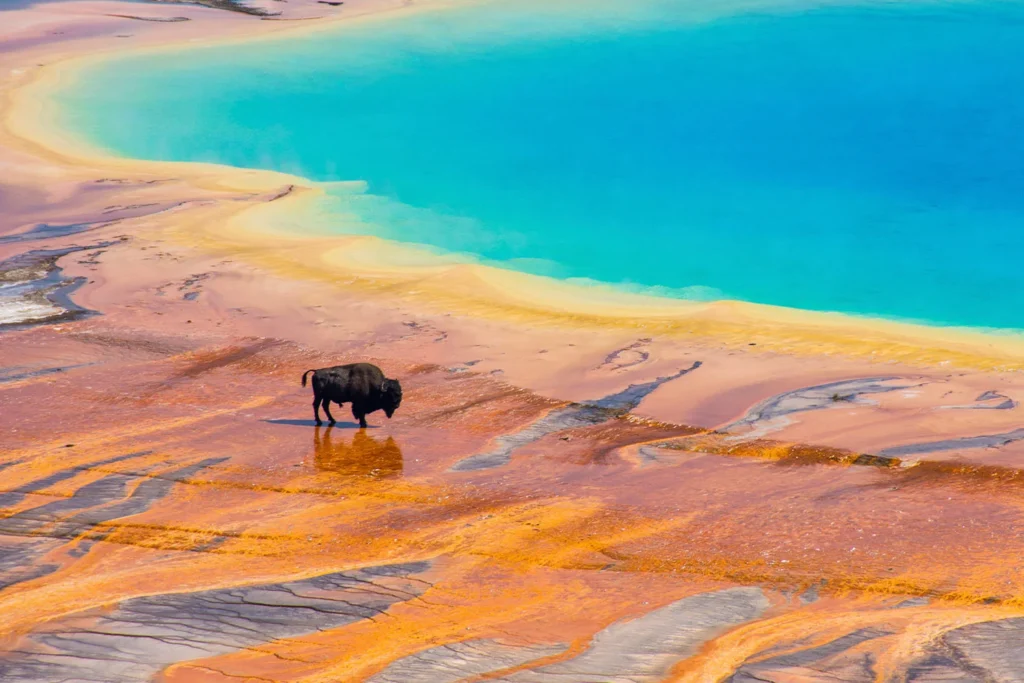
FUN FACT: The water in Grand Prismatic Spring maintains a constant near-boiling temperature, has the alkalinity of baking soda, and is so acidic it can burn holes in clothing. It’s fascinating that the extreme conditions of these hot springs are essential for the survival of the microorganisms living there.
Grand Canyon of Yellowstone
When you think of the Grand Canyon, the one in Colorado might immediately come to mind. However, there’s a Grand Canyon right within Yellowstone National Park, and it’s one of the park’s most breathtaking features. Spanning over 32 km in length, this canyon is particularly fascinating because its walls and floor still host active geysers, steam vents, and hot springs today. These phenomena are linked to its formation, likely resulting from the erosion of a geyser basin formed during earlier lava flows.
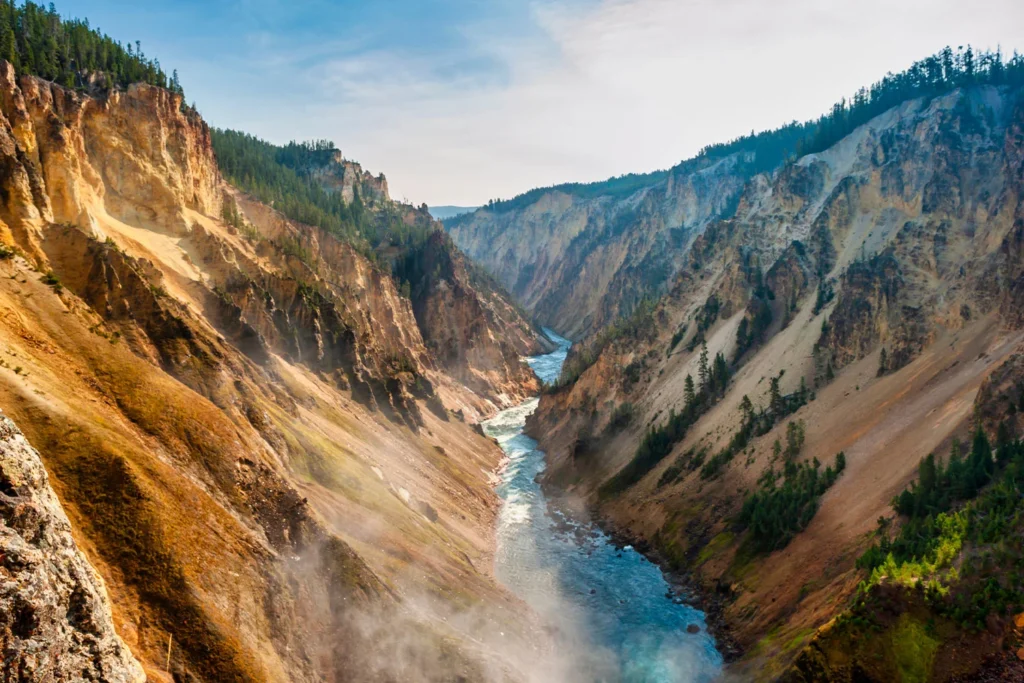
One of the canyon’s highlights includes two spectacular waterfalls. The swiftly flowing Yellowstone River dramatically drops into the canyon, forming the Lower Falls, which stand nearly 94 meters high, and the Upper Falls, cascading around 33 meters. Both natural wonders can be viewed from scenic lookouts along the rim trail that follows the canyon’s edge.
But it’s not just the waterfalls that captivate visitors – many marvel at the canyon’s striking colors, which seem as if painted with pastels. The hues on the canyon walls are what geologists call “mineral stains,” which mark the locations of hot springs and steam vents. For thousands of years, fluids have seeped into the rocks, altering their chemical composition. This is why the canyon appears like a rocky rainbow. Some rocks look rust-colored, others are pinkish or bleached white, while those saturated with iron have taken on a vivid yellow color.
FUN FACT: Contrary to popular belief, the name Yellowstone, which translates to “yellow stone,” does not derive from the yellow rocks in the Grand Canyon of Yellowstone. The name likely originated from Native Americans who noticed the yellow sandstone along the banks of the Yellowstone River in eastern Montana.
Yellowstone Lake
Although it’s not the only body of water enhancing the park’s landscape, Yellowstone Lake certainly deserves the most attention. Covering an area of 342 square kilometers, it is the largest high-altitude lake (above 2,134 meters) in North America. Research has shown that if all the water were drained from the lake, its floor would closely resemble Yellowstone’s land surface, with geysers, hot springs, and deep canyons. This explains why the lake’s hottest spot, Mary Bay, has recorded temperatures as high as 122°C! It’s hard to believe, knowing that the lake is generally considered cold, with an average water temperature of 5°C. Each winter, its surface completely freezes and doesn’t fully thaw until late May.
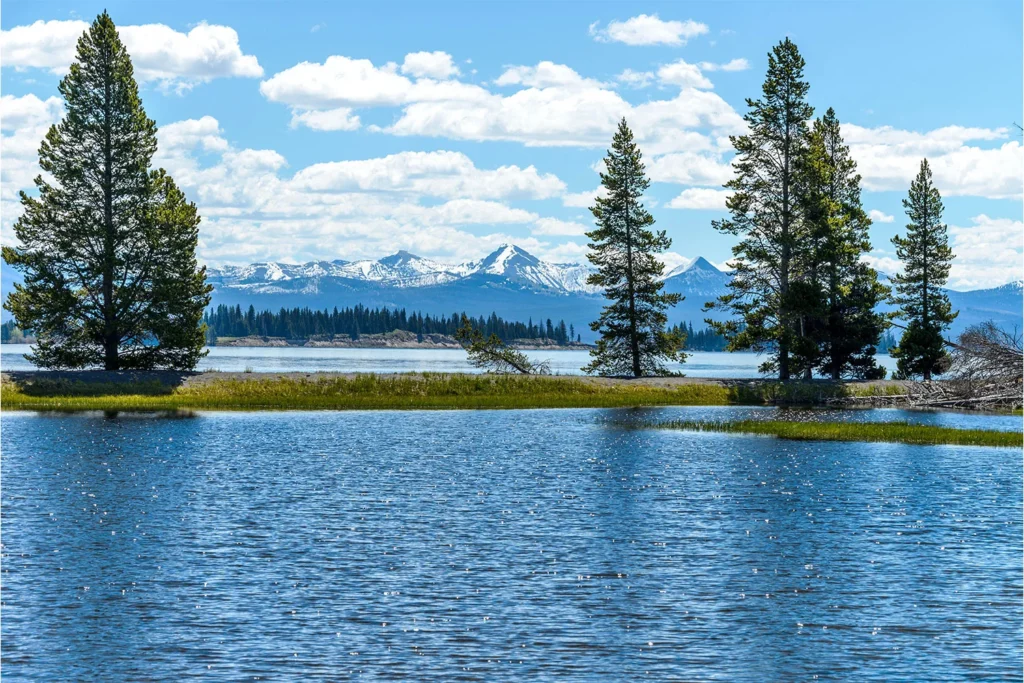
One special resident of Yellowstone Lake is the wild cutthroat trout. The lake hosts the largest population of this fish species in North America. You might wonder what cutthroat trout are doing in the still waters of the lake? For years, this was a mystery, even for experts. Today, the puzzle is considered solved. It’s believed that Yellowstone Lake once drained into the Pacific Ocean through the large canyon and the Snake River, and the fish swam up from the rushing waters of the tributary, becoming native inhabitants of the lake.
Flora of Yellowstone Park
The park is home to over 1,000 native plant species and 170 exotic plant species. Over 80% of all forested areas are covered by pine trees, though they are accompanied by smaller groups of firs, spruces, and willows. Additionally, dozens of flowering plant species have been identified, most of which bloom between May and September, delighting flower enthusiasts. One iconic plant in this category is the yellowstone sand verbena, a rare plant that grows exclusively in Yellowstone. This is one of the park’s unsolved mysteries since related species are typically found in much warmer climates.
Like a Phoenix from the Ashes
Initially, it seems perfectly logical to protect the park’s green areas from wildfires. Preventative measures were taken for many years, but over time, it became evident that these efforts led to significant changes in the vegetation structure. It might come as a surprise to many, but since the 1970s, fires have been allowed to spread naturally in the park. This is because most of the plants in Yellowstone are pyrophytes, meaning they are adapted to survive and even benefit from fire. Today, dozens of natural wildfires occur in the park each year, mostly caused by lightning strikes. The largest recorded wildfire occurred in 1988, burning 36% of the park’s area, but it ultimately contributed to the renewal of the forests.
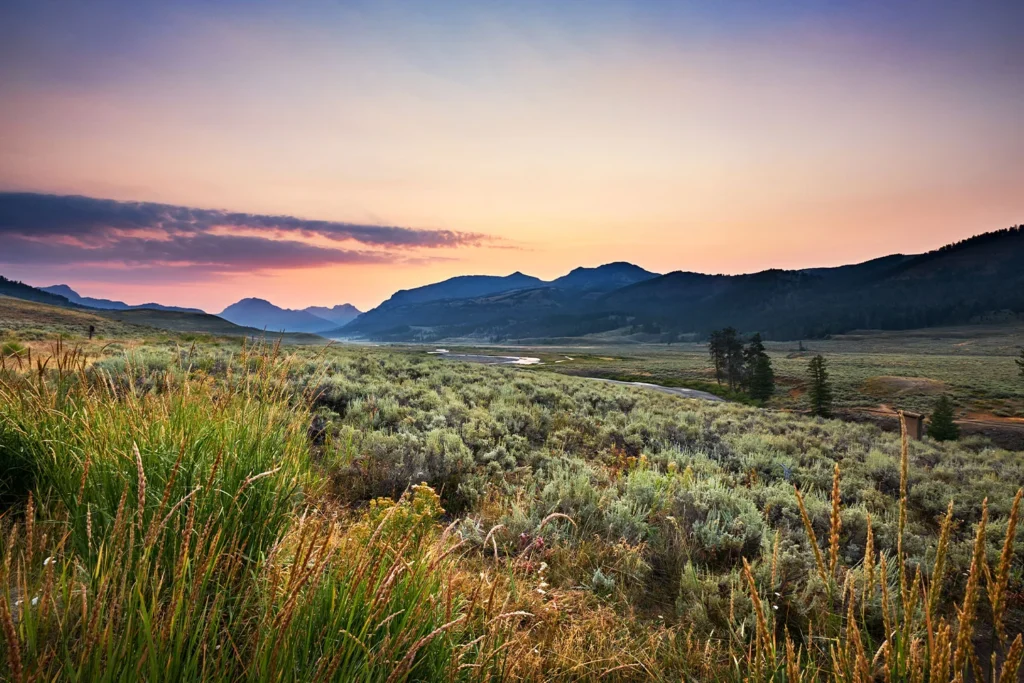
One species that particularly benefits from these fires is the lodgepole pine, one of the primary tree species in Yellowstone. The high temperatures produced by fires are essential for the cones of this pine to open, allowing the species to reproduce.
Fauna of Yellowstone Park
While the plant life in Yellowstone National Park is impressive, the real stars are its wildlife. The protected area is home to animals such as moose, Canada lynx, coyote, jaguar, grizzly bear, and various species of deer and mountain goats. It is also the only place in the continental United States where wild bison have survived.
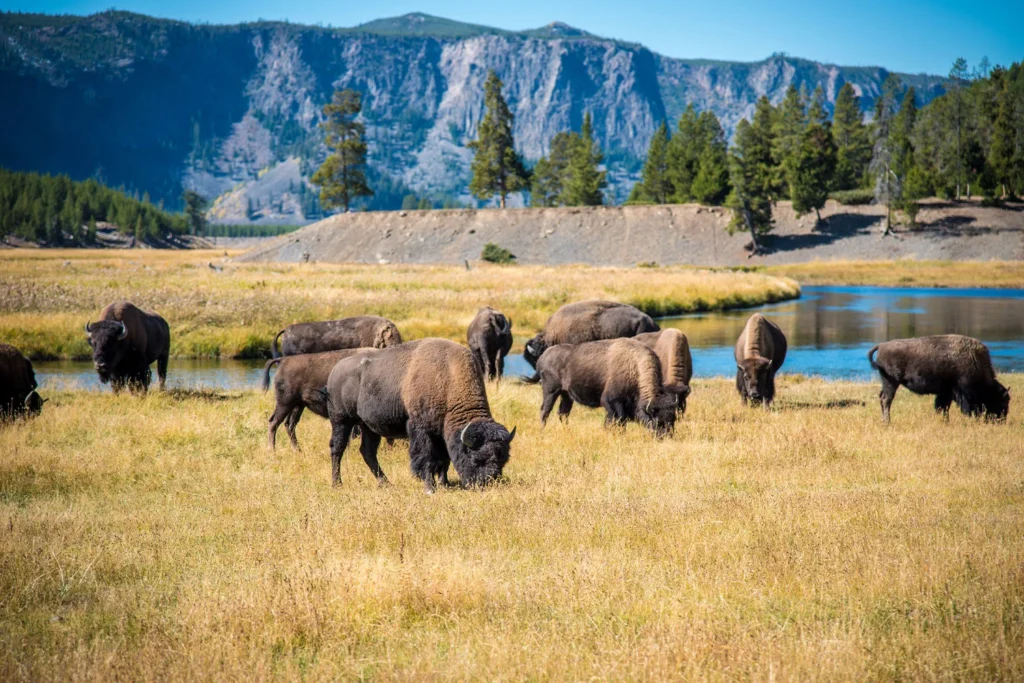
At the beginning of the 20th century, there were only about 50 bison left in the park, but conservation efforts helped restore the population, and today, they are a popular sight for visitors. Another notable resident of Yellowstone is the gray wolf, which was nearly eradicated from most of the U.S. in the early 20th century but was successfully reintroduced to the park at the end of the century.
Additional Attractions of the National Park
The truth is, simply entering Yellowstone National Park and exploring its natural wonders is an unforgettable experience. However, the park authorities have gone the extra mile to offer a range of additional attractions that allow visitors to experience the American wilderness up close. What kind of attractions are we talking about? On Yellowstone Lake, you can rent a boat or motorboat, or even take a guided fishing trip. For getting around the park, you might consider horseback riding or renting a bicycle. There’s also the option of a special photography tour with a guide who will focus on the most photogenic spots based on your skill level. Not interested in those options? Then look for outdoor yoga sessions or stargazing with an experienced astrophysicist.
Occasionally, special marketplaces are set up in different corners of the park, offering traditional snacks, handicrafts created by local Native Americans, or artworks inspired by the landscapes and life in the park. These markets are held on different dates each year, so if you’re interested in such souvenirs, check the schedule on the official park website.
When to Visit Yellowstone National Park?
For many, a visit to Yellowstone is a once-in-a-lifetime adventure. Naturally, everyone wants to plan it as perfectly as possible to avoid disappointment. You might be wondering when the best time to visit is to see the park in all its glory. There’s no definitive answer to that question, as each season in the park offers a unique experience. It’s worth considering which time of year best suits your preferences:
- SPRING – With the arrival of spring, campgrounds and summer cabins in Yellowstone open, allowing you to be closer to the breathtaking nature of the park at any time of day or night. However, this isn’t the main reason why it’s worth planning a trip to the park during the spring months. It’s the most dynamic time of the year. Greenery starts to dominate the landscape, rivers swell with water, and the animals that inhabit these lands awaken from their winter slumber. Spring is also when wildlife families begin to grow, making it the best time to capture young moose, bison, or bears with your camera. It’s also a great time to avoid the summer crowds and enjoy the park’s beauty in a more intimate setting.
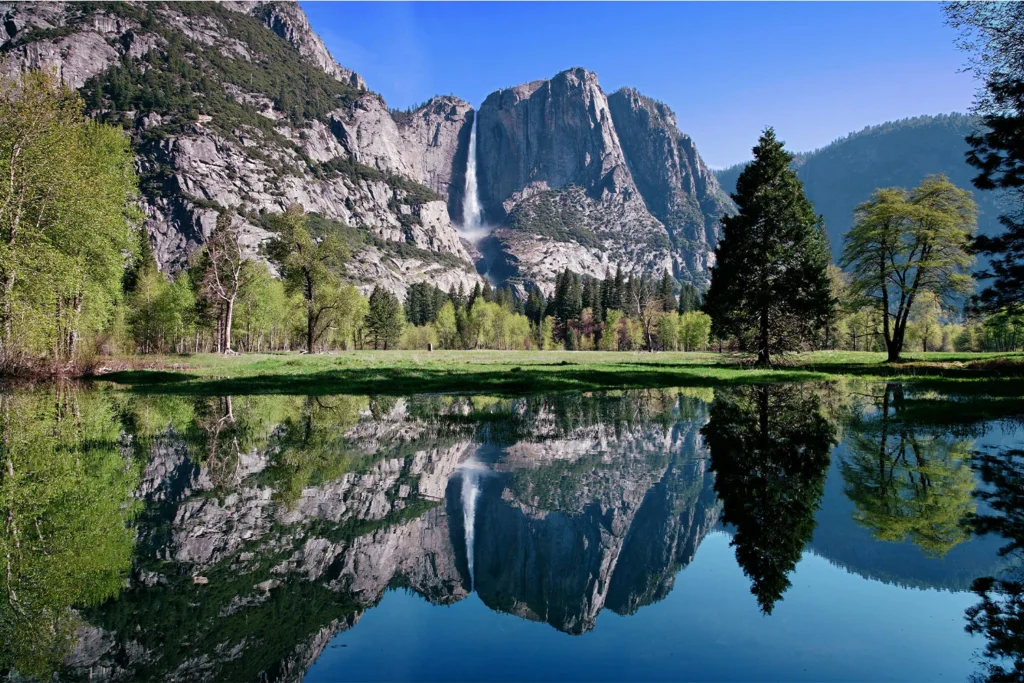
- SUMMER – During the summer months, Yellowstone welcomes the highest number of visitors. While sitting in traffic on the main access roads may not be the most pleasant experience, simply stepping out of the car will make the problem disappear. The vast area of the park allows you to find secluded spots at any time of the year, even during the busiest tourist season. Typically dry summers are the best time for family trips, horseback riding, boat rides, or fishing. This season also brings summer storms, but the good news is that many of them offer stunning sunsets and full rainbows.
- AUTUMN – Golden autumn will compel you to photograph every angle of the aspens, willows, and cottonwood trees as they cloak themselves in magical colors. The star of Yellowstone’s autumn, however, is the elk. It’s their mating season, known as the rut. It’s worth spending plenty of time admiring the dramatic courtship displays of the bulls and listening to their distinctive calls.
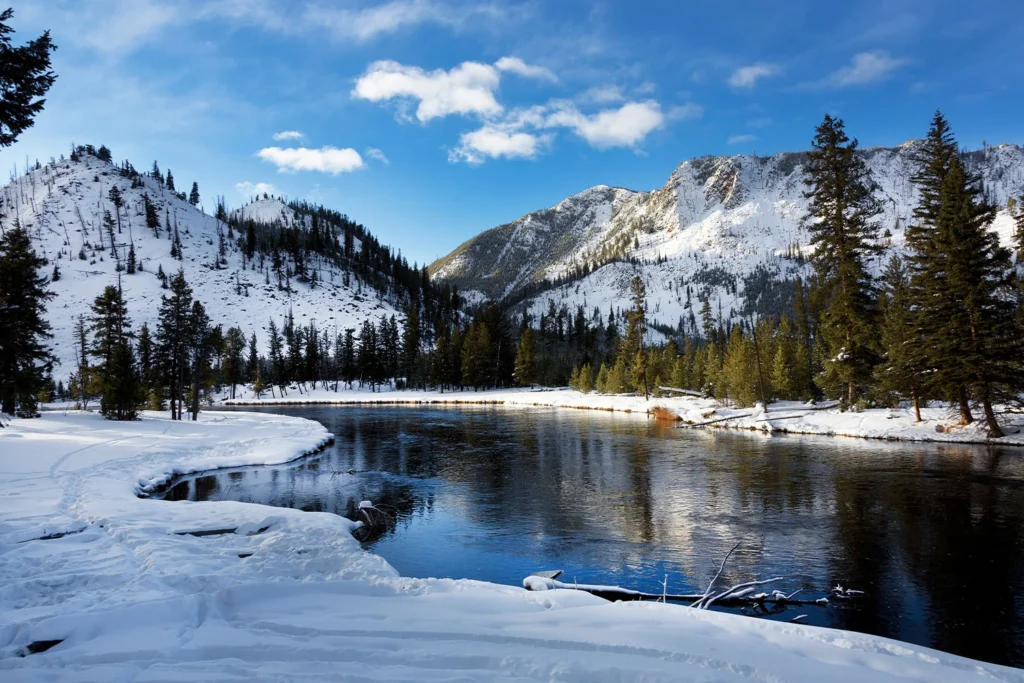
- WINTER – In winter, the park transforms into a snow-covered wonderland. It’s the only time to explore Yellowstone by snowmobile, traverse the slopes with skis on, or glide across the area’s largest lake on ice skates. In the winter atmosphere, you’ll feel the contrast of hot geysers against the frozen world, and you’ll easily spot animals’ shimmering fur against the backdrop of white snow. When planning a winter trip to Yellowstone, you should be prepared for the fact that most roads are impassable, leaving snowmobile rentals as the only option.
Practical Tips – How to Best Explore the Park?
You can explore the park either with a guide by booking a tour that interests you (for example, through the GetYourGuide) or on your own. Each option has its pros and cons, so the choice depends on individual preferences and possibilities. Entrance to the park, whether on foot or by car, is paid, but the good news is that the ticket is valid for 7 days from the first entry. This allows you to plan multiple days in this natural paradise.
There are five different entrances to Yellowstone. The most commonly used is the one located in the northern part of the park, near Mammoth Hot Springs. The North Entrance, as it’s known, is the only gate open to vehicles all year round. The other access roads are open from April or May to November, depending on weather conditions. There is no public transport within the park, so the best option is to rent a car from one of the nearby airports: Bozeman Yellowstone International Airport or Yellowstone Regional Airport (you can arrange this through RentalCars).
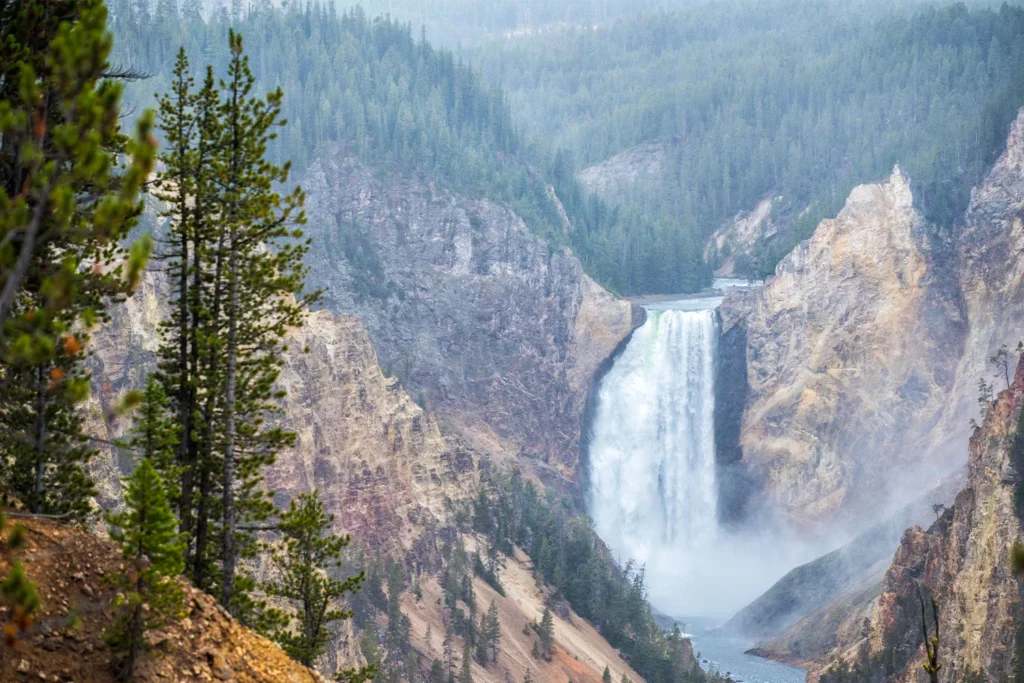
If you’re not driving, you can also rent a vehicle with a driver within the park. Depending on the size of your group, this could be a car, a larger van, or a bus. These charters, offered by the park, help you make the most of your time in Yellowstone. You can either follow suggested routes or customize the trip to your preferences.
When planning a stay in one of the hotels, cabins, or apartments located within the park, make your reservation well in advance—I’m talking about a year ahead, not just months. Of course, there are cancellations and last-minute availabilities, so if you’re organizing a trip spontaneously, it’s still worth checking the availability on the website. However, be prepared for relatively high prices for accommodations. A great and much more economical alternative, especially during the summer months, is camping at one of the park’s campsites.
Forgot your sunglasses, rain jacket, binoculars, or didn’t pack enough food? Don’t worry too much. At various points in the park, you’ll find restaurants and stores offering everything you might need for camping, trekking, and other excursions. You can also refuel your car and buy a souvenir like a magnet with the inscription “World’s first national park,” a hat featuring a bear, or a mug with the Yellowstone logo. As expected, prices are typical of highly touristy places.
What NOT to do in the park?
Now that you know which spots to visit, what to prepare for, and how and when to organize your trip, it’s time for a few warnings to ensure your trip is smooth, hassle-free, and most importantly, safe.
- Don’t try to cram a visit to the park into just one day. Two days is the absolute minimum. The driving distances between various points are much greater than they seem. Additionally, during the summer months, it’s easy to get stuck in traffic due to the sheer number of vehicles or an elk leisurely strolling down the road. Although the park authorities organize special one-day guided tours that allow you to see the most important spots, it’s simply not enough to truly feel the spirit of the place and understand its significance. Take your time. It’s better to spend several days in the park, lingering in each area to fully experience the true magic of Yellowstone.
- Forget about taking selfies with the park’s wild residents. Such photos require getting too close to the animals, which is not the kind of behavior expected from park visitors. The animals work hard to survive the harsh seasonal conditions, and any human interference only makes it harder for them. Make sure you maintain a safe distance from the wildlife, both for your own safety and for the comfort of the animals.
- An important rule in the park is summed up by the saying, “take only pictures, leave only footprints.” Souvenirs can only be purchased in the shops located within Yellowstone, so don’t give in to the temptation of taking home rocks, antlers, or flowers. Removing seemingly insignificant items from the landscape can have a huge impact on the park’s ecosystem, so take a photo and leave them where they belong.
- Just imagine how much it means for the park’s nature when over 3 million visitors, especially during the summer, follow the rules. Park rangers can’t be everywhere, which is why the self-discipline of visitors is so important. Never ignore visible signs in the park, don’t feed the animals, don’t leave trash or food scraps behind, and never enter restricted areas. Following these rules also guarantees your safety.
- Yellowstone is too vast to explore entirely without ever getting into your car, but if you only stick to the main roads, you’ll miss out on the best parts. To fully experience the park’s essence, don’t just take photos through the car windows; go for a walk! Discover the wild trails and the most secret corners of this incredible place. Even a short stroll along a boardwalk can awaken your senses and reveal a completely different side of Yellowstone. This way, you’ll leave behind the sound of engines and crowded paths, and instead, find yourself alone with the park’s fascinating nature.
- If you’re planning a vacation in Yellowstone, don’t expect to swim. The hot springs in the park are not only delicate but can also be deadly. For the protection of these fragile elements of nature, as well as the health and safety of guests, swimming or soaking in the hot springs is strictly prohibited. Swimming in Yellowstone Lake or the rivers is also not recommended due to the extremely low temperatures of the water.
GOOD TO KNOW: While you’re in the area, you can enjoy thermal baths just outside the park. There are many developed hot springs where you can soak and relax. The closest ones to the park are Yellowstone Hot Springs and Chico Hot Springs.
Practical information
- It is worth booking tickets for Yellowstone National Park tours in advance. There are many tours available with experienced guides who will show you the most interesting spots, answer questions, and share fascinating facts about the areas being visited.
- Buy a guided tour on GetYourGuide